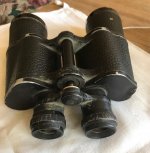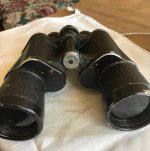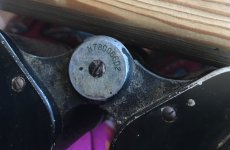-
Welcome to BirdForum, the internet's largest birding community with thousands of members from all over the world. The forums are dedicated to wild birds, birding, binoculars and equipment and all that goes with it.
Please register for an account to take part in the discussions in the forum, post your pictures in the gallery and more.
You are using an out of date browser. It may not display this or other websites correctly.
You should upgrade or use an alternative browser.
You should upgrade or use an alternative browser.
Hi all! I´m new here (1 Viewer)
- Thread starter piaf79
- Start date
More options
Who Replied?WJC
Well-known member
I will receive a binocular from a lady who say it has been used to birdwatching. But i don´t know which type it is. Its only a serial number on it. No info about optic or brand. Is it possible to get this info through the serial number?
Thanks for readingHope for answers
Piaf.
Almost all companies have serial numbers, so that is useless. Your first bit of useful information is that the manufacturer thought so little of the product he neglected to associate his company with it. Could you provide a photo? :cat:
Also, WELCOME!
Bill

Hi Piaf and welcome to Birdforum
Rich
Rich
Hi piaf79.
Welcome.
It's a long time since I visited your area, several times in the 1960s and happy memories.
Also I drove up to Hammerfest, a 10,000 km round trip in my Austin 1800.
I am still a member of the Polar Bear club, with a certificate.
The binocular is I think Russian, rather Soviet, made in 1978.
Possibly a 10x50 Porroprism.
Corroded, but it is strange the rear plates have no markings, they usually do.
Perhaps painted over?
I don't know if there are faint markings somewhere.
There is a faint trace on the left rear plate, but maybe just from a price sticker.
About £10 in this condition.
The binocular needs cleaning, very carefully the optics, and also to remove grease and dust generally.
I cannot see whether the coatings have degraded.
Looks as if the binocular was exposed to salt maybe near the sea.
It may actually work well as some of these binoculars had 1/20th wave prisms.
By the way, in this instance the binocular can be identified from the serial number.
It could be the cover with the number came from another binocular, but unlikely.
Welcome.
It's a long time since I visited your area, several times in the 1960s and happy memories.
Also I drove up to Hammerfest, a 10,000 km round trip in my Austin 1800.
I am still a member of the Polar Bear club, with a certificate.
The binocular is I think Russian, rather Soviet, made in 1978.
Possibly a 10x50 Porroprism.
Corroded, but it is strange the rear plates have no markings, they usually do.
Perhaps painted over?
I don't know if there are faint markings somewhere.
There is a faint trace on the left rear plate, but maybe just from a price sticker.
About £10 in this condition.
The binocular needs cleaning, very carefully the optics, and also to remove grease and dust generally.
I cannot see whether the coatings have degraded.
Looks as if the binocular was exposed to salt maybe near the sea.
It may actually work well as some of these binoculars had 1/20th wave prisms.
By the way, in this instance the binocular can be identified from the serial number.
It could be the cover with the number came from another binocular, but unlikely.
Last edited:
WJC
Well-known member
I am still a member of the Polar Bear club, with a certificate.
On purpose? :cat:
Bill
Yes.
I think I was one of the first members.
It was an easy way for them to make money from mad roadies. Some of the roads were the worst I have ever driven on, like driving on a corrugated roof. I was surprised the Austin was not shaken to bits.
I spent a week in Hammerfest in constant glorious sunshine.
The locals don't seem to sleep.
At midnight the Sun is still bright.
The hotels had very dark black blinds for tourists.
I think I was one of the first members.
It was an easy way for them to make money from mad roadies. Some of the roads were the worst I have ever driven on, like driving on a corrugated roof. I was surprised the Austin was not shaken to bits.
I spent a week in Hammerfest in constant glorious sunshine.
The locals don't seem to sleep.
At midnight the Sun is still bright.
The hotels had very dark black blinds for tourists.
Funny story of you in Hammerfest. Im from Tromsø up north. We didn't sleep much in the summer, its true About the binocular, it was bought in 1960 in Stavanger. From her stepfather. He used it in the boat when fishing, watching birds and neighbors maybe. Some years ago this woman used this binocular to save a mans life. He stood on the rooftop of an 12 floors hotel. She saw him clearly in this binocular that he was about to jump.. and called the Police. They came right away, and it was a happy ending.. can you believe it..!
About the binocular, it was bought in 1960 in Stavanger. From her stepfather. He used it in the boat when fishing, watching birds and neighbors maybe. Some years ago this woman used this binocular to save a mans life. He stood on the rooftop of an 12 floors hotel. She saw him clearly in this binocular that he was about to jump.. and called the Police. They came right away, and it was a happy ending.. can you believe it..!
Hi Piaf,
I don't think it was bought in 1960, although it could have a later spindle cover.
It seems to be a ZOMZ 7x50 from 1978, which had yellow and grey eyepiece filters and a case and strap.
It could however, be a composite binocular made of parts, but apart from the no name rear plate it looks to be the 7x50 ZOMZ or possibly from another Soviet era factory.
Either that or a Soviet 10x50.
The IPD (interpupillary distance) markings also says Soviet.
As does the body covering.
I don't think it was bought in 1960, although it could have a later spindle cover.
It seems to be a ZOMZ 7x50 from 1978, which had yellow and grey eyepiece filters and a case and strap.
It could however, be a composite binocular made of parts, but apart from the no name rear plate it looks to be the 7x50 ZOMZ or possibly from another Soviet era factory.
Either that or a Soviet 10x50.
The IPD (interpupillary distance) markings also says Soviet.
As does the body covering.
Last edited:
Hi Piaf,
I suspect that two binoculars were bought, one in 1960 and the other in or after 1978.
Memory plays tricks, I sometimes find optics that I didn't know I had, and also can't find things that I didn't think I had sold.
Regarding the binocular in the photos, it could be that a repair was carried out or a back plate got damaged and was replaced with a similar one without markings.
It may be that some of these type had markings on the left plate and some on the right. It would be easy to find a replacement plate with no markings.
There is or was a No Name Contax camera. This is what it is called by collectors.
It was I think about the dispute between East and West Zeiss over who owned the names.
If bezels are lifted from some camera lenses another name is found underneath.
When my Minolta camera was repaired the new top plate had a really strange serial number. Only Minolta would know what the replacement serial number meant.
My friend has cobbled together some lenses from different origins and he jokes that future collectors will have a real headache trying to find out what the mystery lenses are.
I suspect that two binoculars were bought, one in 1960 and the other in or after 1978.
Memory plays tricks, I sometimes find optics that I didn't know I had, and also can't find things that I didn't think I had sold.
Regarding the binocular in the photos, it could be that a repair was carried out or a back plate got damaged and was replaced with a similar one without markings.
It may be that some of these type had markings on the left plate and some on the right. It would be easy to find a replacement plate with no markings.
There is or was a No Name Contax camera. This is what it is called by collectors.
It was I think about the dispute between East and West Zeiss over who owned the names.
If bezels are lifted from some camera lenses another name is found underneath.
When my Minolta camera was repaired the new top plate had a really strange serial number. Only Minolta would know what the replacement serial number meant.
My friend has cobbled together some lenses from different origins and he jokes that future collectors will have a real headache trying to find out what the mystery lenses are.
Last edited:
What do you want to know about the serial numbers?
It is unlikely the Russians would reply.
It is either the 6602nd 7x50? made in 1978 or sometimes the numbers after the 78 represent months.
There are numerous codes.
I can date old Kodak lenses, Hasselblad cameras.
Number of elements and groups in old Minolta and Nikon lenses etc. etc.
Canon lenses and binoculars. Where made and when.
Who made binoculars with WW2 codes.
There are also price codes some retailers use.
Some Japanese cameras and lenses have date codes also.
Zeiss, Leica and Swarovski binoculars can be dated.
I would think there are at least 100 codes, probably many more actually.
It is unlikely the Russians would reply.
It is either the 6602nd 7x50? made in 1978 or sometimes the numbers after the 78 represent months.
There are numerous codes.
I can date old Kodak lenses, Hasselblad cameras.
Number of elements and groups in old Minolta and Nikon lenses etc. etc.
Canon lenses and binoculars. Where made and when.
Who made binoculars with WW2 codes.
There are also price codes some retailers use.
Some Japanese cameras and lenses have date codes also.
Zeiss, Leica and Swarovski binoculars can be dated.
I would think there are at least 100 codes, probably many more actually.
Last edited:
Personally, I think the binocular is original with a replacement back plate.
When the serial numbers have, say, 78 followed by another number, that number may be the month.
In this case because of the zeros I think that it may be the 6602nd binocular of that type made in 1978.
This wouldn't surprise me if it is the 7x50 as many were made and they have a good reputation.
I am not certain if every binocular type had their own serial number list or whether say 7x50s and 10x50s were included in the same listing.
With Dallmeyer lenses, each one was listed in enormous stock books with hand written date of manufacture and serial number. There were many volumes, which I went through.
Some British WW2 lenses had no numbers and no maker's name as they were produced in large volumes and had very poor quality alloy mounts.
There were vast differences in resolution as they were made in great haste.
The Taylor Hobson lenses were generally better, although the associated NOC, National Optical Company, mainly made in shadow factories were more variable.
Taylor Hobson lenses are marked TT followed by the serial number.
(The Dallmeyers were usually VV or UU followed by the serial number}.
So, at a guess, with the 7x50 KOMZ, at least 10,000 may have been made per year for many years.
It may also have been supplied to the military.
Export versions were usually of higher quality than civilian home models.
I have no idea really, but there may be over 100,000 Soviet 7x50 Porroprism binoculars.
They are basically hand made the old fashioned way.
I presume yours is single blue coated but maybe on only a few surfaces.
The Russian months maybe the same sequence as ours, but Japanese production months used to start in April, with only ten coded digits, which meant that the January numbers included February and March.
Also the year digits repeated every decade, but one could guess from the camera model when it was made, but not always.
Leica camera accessories may have hundreds of different codes, so the total number of optics codes may be even a thousand.
When the serial numbers have, say, 78 followed by another number, that number may be the month.
In this case because of the zeros I think that it may be the 6602nd binocular of that type made in 1978.
This wouldn't surprise me if it is the 7x50 as many were made and they have a good reputation.
I am not certain if every binocular type had their own serial number list or whether say 7x50s and 10x50s were included in the same listing.
With Dallmeyer lenses, each one was listed in enormous stock books with hand written date of manufacture and serial number. There were many volumes, which I went through.
Some British WW2 lenses had no numbers and no maker's name as they were produced in large volumes and had very poor quality alloy mounts.
There were vast differences in resolution as they were made in great haste.
The Taylor Hobson lenses were generally better, although the associated NOC, National Optical Company, mainly made in shadow factories were more variable.
Taylor Hobson lenses are marked TT followed by the serial number.
(The Dallmeyers were usually VV or UU followed by the serial number}.
So, at a guess, with the 7x50 KOMZ, at least 10,000 may have been made per year for many years.
It may also have been supplied to the military.
Export versions were usually of higher quality than civilian home models.
I have no idea really, but there may be over 100,000 Soviet 7x50 Porroprism binoculars.
They are basically hand made the old fashioned way.
I presume yours is single blue coated but maybe on only a few surfaces.
The Russian months maybe the same sequence as ours, but Japanese production months used to start in April, with only ten coded digits, which meant that the January numbers included February and March.
Also the year digits repeated every decade, but one could guess from the camera model when it was made, but not always.
Leica camera accessories may have hundreds of different codes, so the total number of optics codes may be even a thousand.
Users who are viewing this thread
Total: 2 (members: 0, guests: 2)






